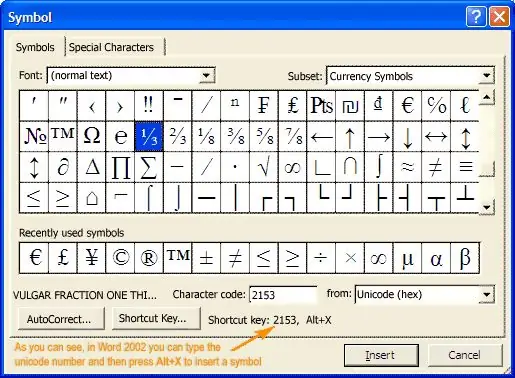Fractional expressions are common in technical, scientific, and educational texts. In the simplest cases, you can get by with the usual oblique slash. However, in the case of "multi-level expressions" you will have to use additional features of Word.

It is necessary
Computer, Word
Instructions
Step 1
The simplest fractions can be printed by inserting special characters that represent some common fractions. To do this, select the "Insert-Symbol" menu items. In the appeared plate with a set of symbols, select the sign of the desired fraction (if it is there). Unfortunately, the list of available fractional characters is very limited and is limited to the following values in standard fonts:?,?,?,?,?,?,?,?,?. The set of preset fractions may differ depending on the font selected in the "Font" field. However, if some special font provides a large selection of fractions, this does not mean at all that on another computer these characters will be displayed the same way.
Step 2
It is convenient to re-enter fractions using the special panel "Previously Used Symbols".
If the above fractions are used very often, then here you can also configure hotkey combinations or autocorrect options.
Step 3
To print any fraction, type its numerator, then the forward slash (/), followed by the fraction's denominator. To give such a fraction a more natural look, select the numerator, press the right mouse button, select the line "Font" in the drop-down context menu and put a check in the box with the word "superscript". Do a similar operation with the denominator of the fraction. Just put a tick in front of the word "subscript".
Step 4
You can print a fraction by combining vertical offset and font size reduction. Type the numerator and denominator of a fraction, separating them with a slash. Now select the numerator and select the "Font" item in the context (or main) menu. Specify a font size that is about a third smaller than the established one (for example, 8 pt instead of 12 pt). Then go to the "Spacing" tab and in the "Offset" line select the "Up" value. The offset value can be left at the default. After that, perform a similar procedure with the denominator. Only "Offset" needs to be selected "Down".
Step 5
If the fraction sign (horizontal bar) is used in complex mathematical expressions, then such a bar (like the entire expression) is best printed using the formula editor. To do this, sequentially select the following menu items: "Insert - Object - Microsoft Equation 3.0". After that, the editor of mathematical formulas will start, where you can print any fraction. If the “Microsoft Equation 3.0” object does not appear in the drop-down menu, then this option was not installed when Word was installed. To do this, insert the disc with the Word program of the same version and run the installation program. Check the box Microsoft Equation 3.0 and after installation this feature will become available. In Microsoft Word 2007, the formula editor is already built into the taskbar.
Step 6
You can print a complex fraction in Word in another way. Select the following items: "Insert - Field - Formula - Eq". Now select the fraction icon in the editor that opens.
Step 7
You can print a fraction using a special "character" formula editor. To do this, press the key combination Ctrl + F9. Then, inside the curly braces that appear, type: eq f (1; 2) and press F9. The result will be one second, recorded in the classic, "vertical" form. To get the desired fraction, instead of one, type the numerator, and instead of two, the denominator of the fraction. By the way, the resulting fraction can be further edited with a "regular" formula editor.
Step 8
As a last resort, you can draw the fraction symbol (horizontal bar) yourself. To do this, expand the drawing panel, select the line tool and draw a suitable horizontal line. To "add" the numerator and denominator to the resulting line, in the settings of the "text wrap" option, select "before the text" or "behind the text".






